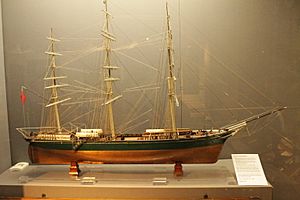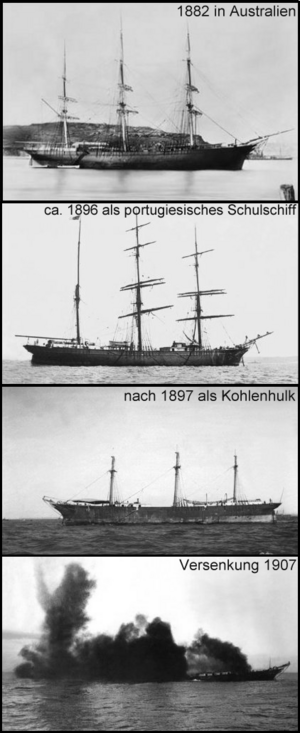Thermopylae (clipper) facts for kids

Thermopylae
|
|
Quick facts for kids History |
|
|---|---|
| Name | Thermopylae |
| Builder | Walter Hood & Co, Aberdeen |
| Launched | 1868 |
| Notes | Design of Bernard Waymouth, London |
| Name | Pedro Nunes or Pedro Nunez |
| Fate | Torpedoed at sea, 13 October 1907, off Cascais |
| General characteristics | |
| Class and type | Composite extreme clipper; naval training ship |
| Tonnage |
|
| Length | 212 ft (64.6 m) |
| Beam | 36 ft (11.0 m) |
| Depth | 20.9 ft (6.4 m) |
| Sail plan | fully rigged ship |
The Thermopylae was a very fast sailing ship called an clipper. It was built in 1868 in Aberdeen, Scotland. This amazing ship was designed to carry tea quickly from China. On its first trip to Melbourne, Australia, it set a speed record. It completed the journey in just 63 days! This is still the fastest trip ever made by a sailing ship on that route.
Building a Fast Ship
The Thermopylae was built for the Aberdeen Line, a shipping company started in 1825. It was 212 feet (64.6 meters) long and 36 feet (11 meters) wide. The ship was built using a special method called "composite construction." This meant it had a strong iron frame covered with wooden planks.
The bottom part of the hull (the ship's body) was made of American rock elm wood. The upper part was made of teak wood. This design made the ship very strong and light. Its shape was also very sleek, which helped it cut through the water quickly. The main masts were made of iron, which was also very strong.
Speed and Journeys
The Thermopylae was made for the "China tea trade." This meant its main job was to bring tea from China to Europe. On its way to China, it usually sailed to Australia first.
Its first journey started in November 1868. It sailed from Gravesend, England, to Hobsons Bay, Melbourne, Australia, in a record-breaking 63 days. That's super fast for a sailing ship!
When it returned from China, carrying tea, it usually took about 106 days. The ship was especially good at sailing in light winds. It was also very fast when sailing against the wind. These skills were important for crossing the China Sea, where winds could be tricky. Being fast in these conditions helped it get the tea back to London quickly.
Race Against Cutty Sark
In 1872, Thermopylae had a famous race against another well-known clipper, the Cutty Sark. Both ships were sailing from Shanghai, China, back to London. Thermopylae won the race by seven days! Cutty Sark had some trouble during the race when it lost its rudder.
Thermopylae once sailed 380 miles in a single day. No other sailing ship had ever done that before!
After 1879, steamships started taking over the tea trade. So, Thermopylae began sailing to Sydney, Australia, and carrying wool back to England. On this route, the Cutty Sark was actually faster. This was because the wool trade route didn't have as many light winds, where Thermopylae had an advantage.
In 1890, Thermopylae was sold to new owners in Canada. It was then used to carry timber (wood). Its sails were changed to a simpler design called a barque. Some of its masts were also made shorter.
Life as a Portuguese Ship
In 1895, Thermopylae was sold to the Portuguese government. They renamed it Pedro Nunes. The plan was to use it as a training ship for their navy. It arrived in Portugal in 1896 and officially joined the Portuguese Navy.
However, it was never actually used as a training ship. Instead, it became a "coal hulk." This means it was used to store coal for other ships.
On October 13, 1907, the Pedro Nunes had its final journey. It was towed out to sea during a special event attended by the Queen of Portugal. There, it was sunk by torpedoes. This was done as a target practice exercise, marking the end of its long and famous life at sea.




